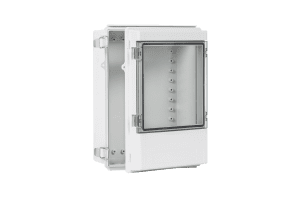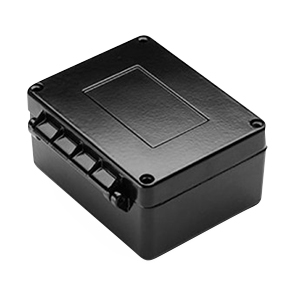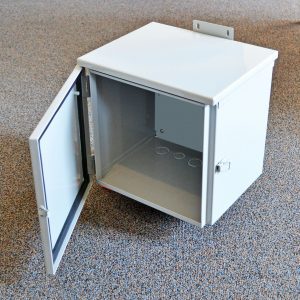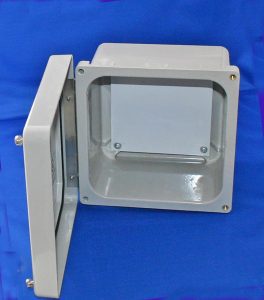by Ravi Jain, Bud Industries Inc.
Some 30 years ago, NEMA-rated enclosures were used only in electrical applications. Today, as electronics have invaded areas such as factory automation, indoor and outdoor controls, and telecommunications, NEMA is the fastest growing segment of the electronics enclosure industry.
NEMA standards define the various levels of environmental protection. When an application is wet, dirty, or washdown, NEMA enclosures are the obvious solution.
What’s not so obvious is which type of material to select for the NEMA enclosure box. Most U.S. engineers automatically choose metal enclosures – wasting money and flexibility. In fact, economical NEMA enclosures are available in a wide variety of materials including plastic, die-cast aluminum, steel and aluminum sheet metal, and fiberglass. Each type of material has its pros and cons, and it’s an important decision, because it determines how and where the device can be used. The choice of material depends on the application, budget, and degree of customization required.
Plastic Electrical Enclosures

AIO IP66 All-In-One Hinged Clear Window Enclosure
Despite the climbing price of oil, plastic is still the lowest cost option for NEMA enclosures. It isn’t as rugged as metal, but it has some unique properties that make it a useful choice. For starters, plastic enclosures are lightweight, which makes them easy to carry. Many small hand-held and portable devices are packaged in plastic electrical enclosures. If a polycarbonate plastic enclosure weighs 1 pound, the same enclosure made of fiberglass would weigh about 1.5 pounds, of aluminum 2 pounds, and of steel more than 6 pounds.
Plastic can be molded into infinite shapes, allowing for molded-in battery compartments, recessed covers, rounded corners, and other useful design features typical of small handheld enclosures.
Also unique is the option of transparency. NEMA enclosures can have a see-through cover, allowing LEDs and other indicators to be visible without the need to open the cover or provide gasketed or sealed openings.
Plastic enclosures can house instruments that may be affected by metal. If this is a requirement, then don’t forget to specify non-metallic fasteners and latches, which enclosure suppliers make available as an option.
Because plastic is naturally corrosion resistant, it can be used outdoors and in washdown environments. Especially in Europe, plastic electrical enclosures are often used for junction boxes and to house industrial controls. Contrary to popular belief, plastic boxes are easily wall- and machine-mounted.
Stock plastic enclosures come in a limited number of colors, but for large quantities, custom colors are available. Finding custom size plastic enclosures is a bit more challenging. The tooling required for modifications can cost any where from $5,000 to $40,000 depending on the size and complexity. Fortunately, a large variety of dimensions are available from stock.
Plastic enclosures are typically injection-molded out of polycarbonate plastic. The plastic can be formulated to provide UV stability and flame resistance.
Enclosures made of ABS plastic (Acrylonitrile Butadiene Styrene) find service in many applications. The reason to choose an ABS enclosure is as a low-cost alternative in indoor applications where a rating is not required. They are heavier and have less impact resistance than enclosures made of polycarbonate plastic. Also, ABS plastic cannot be transparent, so some enclosures have bodies of ABS and clear covers made of polycarbonate.
Die Cast Aluminum Enclosures

AN Hinged Die Cast Aluminum Enclosure
Die-cast aluminum housings are also lightweight, but they offer more compression strength and rigidity than plastic. The casting process results in walls that are comparatively thicker, making the enclosure very strong and impact resistant. Typically, die-cast aluminum enclosures are used to house electronic, pneumatic, hydraulic and electrical devices. They are especially good for housing sensitive electronics assemblies because of the EMI shielding and heat dissipating quality of aluminum.
The metal transfers heat well and is corrosion resistant. Die-cast aluminum housings are commonly available with optional mounting flanges, which are either welded or formed as part of the die. Look for the mounting flange to be on the box body, rather than the lid – otherwise, the box cannot be opened without first removing it from the wall or machine.
Unlike plastic, die-cast aluminum enclosures can be ordered with a mar-resistant powder coat finish in a choice of colors. This not only enhances the relatively corrosion resistant property of aluminum, it is also a way to differentiate a product in the marketplace.
Extruded Aluminum Enclosures
Extruded aluminum enclosures can be produced cost effectively. The bodies are basically tubular in design. Plastic caps or bezels cover the ends, which can add functionality such as infrared panels. Despite an affordable price, extruded aluminum enclosures can have stylish caps and finishes. As with other metal enclosures, the aluminum housing conducts heat away from the electronics. Some models feature built-in card guides.
Sheet Metal Enclosures
Steel sheet metal enclosures provide a nicer appearance than die-cast aluminum, while providing the same

The N3R Enclosure series provide excellent NEMA 3r outdoor protection
benefits of heat dissipation, EMI shielding, and compression strength. Sheet metal enclosures are more durable and also heavier than those made of other materials. In low quantities, sheet metal enclosures can be expensive, but in large quantities they are economical. However, custom enclosures in low quantities and large enclosures are generally most economical in sheet metal because of comparatively low tooling costs.
Steel is not as corrosion resistant as aluminum, but with a powder coat finish, it can meet the same NEMA standards as enclosures made of other materials. For outdoor applications needing a long service life, stainless steel performs far better, albeit at a high cost. Bud offers a stainless steel enclosure that is lower in cost than most. Typical applications include instrument cases, control housings, terminal wiring enclosures, meter cases, junction boxes, and marine applications.
Formed by bending sheet metal and welding, sheet metal NEMA boxes having custom dimensions can be easily sourced. These come at a premium price over stock enclosures, which are available in a wide variety of sizes.
Enclosures made of sheet metal are available in aluminum, too. The main advantages of aluminum sheet metal enclosures: compared to steel they are lighter weight, lower cost, and naturally corrosion resistant. Aluminum used to be the first choice for portable enclosures, but today plastic is more commonly used.
Fiberglass Enclosures

NF Series Fiberglass Enclosure
Fiberglass enclosures offer many of the same advantages of plastic enclosures such as water and corrosion resistance. They are appropriate for indoor washdown and outdoor environments. Fiberglass combines the benefits of plastic with glass fibers to add rigidity and impact-resistance. Fiberglass is stronger than ABS or polycarbonate plastic – in fact, it is stronger than steel of the same weight. Lifting a large enclosure for wall or pole mounting will be much easier if the enclosure is made of fiberglass instead of metal.
Compared to polycarbonate plastic, fiberglass has a superior operating temperature (-31 degrees F to 300 degrees F.) The disadvantage is that fiberglass enclosures cost up to twice as much as ABS or polycarbonate plastic enclosures. They are also expensive to tool because of the toughness of the glass fibers. They are also less impact resistant than other types of plastic enclosures. The inclusion of the glass fibers also means that they are not as “clean” looking and can have some ragged edges.
Read more selection tips for fiberglass enclosures on our blog post.
Fiberglass Reinforced Polycarbonate Enclosures
Recently, polycarbonate plastic enclosures reinforced with 10 percent glass fibers have become available. This material has much less fiber content than traditional fiberglass, which lowers the cost and improves the appearance. Such enclosures are stronger than plain polycarbonate boxes. (Watch a video of what happens when a car drives over such an enclosure.) Also, the fibers add stability during molding, so tolerances are tighter.
Modifying NEMA Enclosures
Increasingly, company managers are requesting modifications from their enclosure suppliers. The manufacturer can insure that the modifications are done properly using the best possible tools and it lets companies focus on core competencies and lower manufacturing costs. It can add value by providing customers with tailored solutions, such as mounting holes in a custom configuration, or by enhancing the design, such as with CNC machining of custom shaped openings.
Unfortunately, NEMA box enclosures can be tricky to modify. Any openings cut in into the box could compromise the NEMA rating, and ventilation may be limited or impossible, depending on the desired NEMA rating.
Cable glands are an inexpensive and effective way to seal the holes where cables exit the enclosure. Other openings may require your supplier to add custom gaskets. Also, consider heat build-up in the design, and make use of passive heat dispersing tactics.
Often, plastic and die-cast NEMA boxes are molded with internal bosses and card guides. Upon request, the supplier will can mill them off to provide greater internal capacity. Sometimes modifications can be added to the outside without affecting the NEMA rating, such as adding latches, lock hasps, mounting brackets, and carrying handles. Of course, suppliers are often willing to provide custom finishes, silk screening, and labels. Note that any customization such as unique sizes or material changes will often require that the enclosure be re-submitted to UL.
Conclusion
More and more devices are being packaged in NEMA-rated enclosures, a trend fueled by increasing customer demand and falling costs. By choosing the ideal material for a NEMA enclosure, engineers can protect their designs for the lowest possible cost.
NEMA Protection Standards
The National Electrical Manufacturer’s Association has standardized the various levels of environmental protection for enclosures. In a recent survey, more than 70 percent of engineers were confused by the different NEMA ratings. In addition, the survey suggests that 40 percent of all enclosures that require protection are specified to the wrong level. Most engineers use a level that does not provide adequate protection for their design’s intended application; the balance is overkill, which adds unnecessary cost.
At the low end of the range, NEMA 1 provides a basic level of protection – just enough that you cannot put your finger inside the unit and the internal components are protected from incidental contact. This is a basic level that provides the product with safety but not with environmental security.
At the high end of the range, a NEMA 4 enclosure provides all the protection of NEMA 1 plus protection against sprayed liquids and the ability to withstand the formation of ice. This is a high degree of security that is not required in many situations, except in outdoor applications.
The most misunderstood rating is NEMA 12. Although it has a higher number, it covers enclosures for indoor use only. It provides protection against falling dirt, circulating dust and fibers, and dripping water. Cabinet racks for indoor use are often specified to NEMA 12.
Common NEMA enclosure types and approximate IEC IP equivalencies
NEMA
Type no. | NEMA enclosure definition | IEC
class* |
| 1 | Constructed for indoor use to provide a degree of protection to personnel against access to hazardous parts and to provide a degree of protection of the equipment inside against ingress of solid foreign objects (falling dirt). | IP10 |
| 4 | Constructed for indoor or outdoor use to provide a degree of protection to personnel against access to hazardous parts; to provide a degree of protection of the equipment inside against ingress of solid foreign objects (falling dirt and wind blown dust); to provide a degree of protection with respect to harmful effects on the equipment due to ingress of water (rain, sleet, snow, splashing water, and hose directed water); and that will be undamaged by the external formation of ice on the enclosure. | IP56 |
| 4x | Same as Type 4 except provides additional protection against corrosion. | IP56 |
| 12 | Constructed (without knockouts) for indoor or outdoor use to provide a degree of protection to personnel against access to hazardous parts; to provide a degree of protection of the equipment inside against ingress of solid foreign objects (falling dirt and circulating dust, lint, fibers, and flyings); and to provide a degree of protection with respect to harmful effects on the equipment due to ingress of water (dripping and light splashing). | IP52 |
* NEMA type typically equals or exceeds the IEC IP rating shown.





